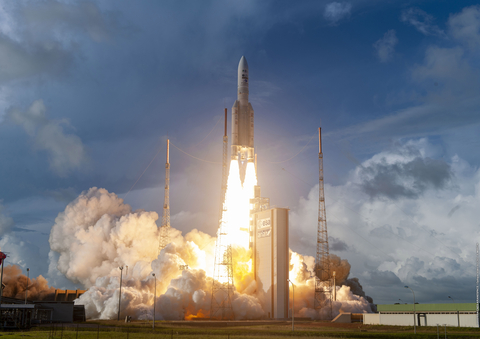DARMSTADT, Germany--(BUSINESS WIRE)--Tonight’s launch of a highly advanced meteorological satellite from, Kourou, French Guiana, heralds the start of a new era for weather forecasting in Europe, EUMETSAT Director-General Phil Evans said.
The satellite, MTG-I1, is the first of a new generation of meteorological satellites carrying more advanced and precise instruments for monitoring and forecasting severe weather events such as storms, lightning, fog and wildfires.
It was successfully launched on an Ariane-5 rocket at 21:30 CET and is on its way to its correct orbit, 36,000km above the Equator.
“MTG-I1 will generate images of Europe and Africa every 10 minutes, faster than has been possible up until now, and in higher resolution, more precise detail,” Evans said.
“This data will help meteorologists meet one of their main challenges – timely and accurate forecasts of rapidly developing severe weather events – so that citizens, first responders and civil authorities can take appropriate action.
“The satellite’s lightning imager will continuously map lightning flashes between clouds and from clouds to the ground, which is a first for Europe with significant community and aviation industry safety benefits.”
MTG-I1 – full name Meteosat Third Generation – Imager 1 – will undergo a 12-month commissioning phase, in which its instruments will be calibrated and the data they produce validated, before becoming operational.
It will be operated from EUMETSAT’s headquarters in Darmstadt, Germany.
“Meteosat Third Generation is a European success story,” Evans said. “No European nation could afford to develop and operate such a system on its own. By combining the resources of our 30 member states, including their scientific and technical expertise, we are able to bring about a new era in weather and climate monitoring.”
More information about MTG-I1 can be found here.
Brochure containing facts and figures and other information about the MTG system can be found here.
The full Meteosat Third Generation constellation will comprise two imaging satellites and, for the first time, a sounding satellite. MTG – Sounder 1, is expected to be launched in 2024.
MTG-I1 was built by Thales Alenia Space under contract by the European Space Agency (ESA). ESA is responsible for procuring the satellites from industry fulfilling EUMETSAT’s requirements.
Thales Alenia Space Cannes is the prime industrial partner for the development of the MTG-I satellites. TAS works in close cooperation with:
• OHB-Bremen, which assembled, integrated and tested the platform
• LEONARDO in Italy, which provided the Lightning Imager instrument
• Thales Alenia Space Italy, which delivered the Data Collection and GEO SAR instruments
• Thales Alenia Space Cannes also integrated the Flexible Combined Imager.
For more information, visit the EUMETSAT website.
About EUMETSAT
EUMETSAT, Europe’s meteorological satellite agency, monitors the weather and climate from space. Based in Darmstadt, Germany, EUMETSAT provides its 30 member states with meteorological imagery and data that are essential for keeping their communities safe and for the benefit of critical sectors of their economies.
Three Meteosat Second Generation satellites in geostationary orbit deliver continuous observations of fast developing severe weather events over Europe, Africa and the Indian Ocean. The first of the Meteosat Third Generation satellites was launched in December 2022 and will undergo 12 months’ in-orbit commissioning. Two polar-orbiting Metop satellites provide data of pivotal importance for forecasts up to 10 days ahead. The first of the second-generation Metop satellites is expected to be launched in 2025.
EUMETSAT’s archive of satellite observations over more than 40 years provides climate scientists around the world with long-term, homogenous data necessary for monitoring climate change.
EUMETSAT is a key partner in the European Union’s Copernicus Earth observation programme. It operates the Copernicus Sentinel-3 and -6 ocean-monitoring missions, and will operate the upcoming CO2M mission, to monitor carbon dioxide emissions. EUMETSAT will fly the Copernicus Sentinel-4 and -5 missions on board its own MTG and Metop-SG satellites. Data from these Sentinels, and EUMETSAT’s own missions, are provided to the Copernicus climate, atmosphere monitoring and marine environment services. Along with European Space Agency and the European Centre for Medium-Range Weather Forecasts, EUMETSAT is a partner in the EU’s DestinE initiative, creating digital twins of the entire Earth system.
Together with NASA, NOAA, the EU, ESA and with support from the French Space Agency, CNES, EUMETSAT is a partner in the Jason and Copernicus Sentinel-6 ocean-monitoring missions.
EUMETSAT cooperates with agencies around the world, securing additional satellite data of benefit to weather forecasting and climate monitoring.
EUMETSAT’s 30 member states are: Austria, Belgium, Bulgaria, Croatia, Czech Republic, Denmark, Estonia, Finland, France, Germany, Greece, Hungary, Iceland, Ireland, Italy, Latvia, Lithuania, Luxembourg, the Netherlands, Norway, Poland, Portugal, Romania, Slovakia, Slovenia, Spain, Sweden, Switzerland, Türkiye and the United Kingdom.




